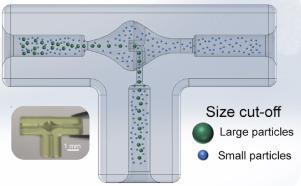Viscoelastic particle enrichment using a 3D-printed enrichment device
IF 4.9
3区 工程技术
Q2 ENGINEERING, ELECTRICAL & ELECTRONIC
引用次数: 0
Abstract
Sample enrichment is of paramount importance in studying complex cell populations such as blood cells, stem cells, and bacterial communities, as it enables to increase the concentration of target cells, enhances detection sensitivity for low-abundance members, and reduces interference from non-target components. Current enrichment techniques face limitations regarding modularity, dynamic size range, and design complexity.
Here, we present a feasibility study using projection micro-stereolithography 3D-printing technology to demonstrate a microfluidic device for size-based particle separation and enrichment. This device leverages the advantages of viscoelastic flow focusing and integrates a 3D-printed reverse nozzle with fused silica microcapillaries, thus enabling separating flow-focused particles of a specific size cutoff and their background. By varying the inlet capillary inner diameter, our device demonstrates tunable separation capabilities, as illustrated using polystyrene microparticles (1–10 m). Pilot experiments further show its applicability for enriching algae and stem cells from bacterial contaminants. With its low cost, rapid fabrication, modularity, and dual-outlet design that enables simultaneous collection of both target cells and contaminants, the 3D-printed microfluidic device offers a cost-effective alternative for a range of diagnostic and preparative applications.

粘弹性颗粒富集使用3d打印富集装置
样品富集在研究复杂细胞群(如血细胞、干细胞和细菌群落)中至关重要,因为它可以增加靶细胞的浓度,提高对低丰度成员的检测灵敏度,并减少非靶组分的干扰。当前的浓缩技术面临着模块化、动态尺寸范围和设计复杂性等方面的限制。在这里,我们提出了一项可行性研究,使用投影微立体光刻3d打印技术来演示基于尺寸的颗粒分离和富集的微流体装置。该设备利用粘弹性流动聚焦的优势,将3d打印的反向喷嘴与熔融二氧化硅微毛细管集成在一起,从而能够分离特定尺寸截止点及其背景的流动聚焦颗粒。通过改变入口毛细管内径,我们的设备展示了可调的分离能力,如使用聚苯乙烯微粒(1-10 μm)所示。试点实验进一步证明了它在从细菌污染物中富集藻类和干细胞方面的适用性。凭借其低成本,快速制造,模块化和双出口设计,可以同时收集目标细胞和污染物,3d打印微流体装置为一系列诊断和制备应用提供了经济高效的替代方案。
本文章由计算机程序翻译,如有差异,请以英文原文为准。
求助全文
约1分钟内获得全文
求助全文
来源期刊

Sensors and Actuators A-physical
工程技术-工程:电子与电气
CiteScore
8.10
自引率
6.50%
发文量
630
审稿时长
49 days
期刊介绍:
Sensors and Actuators A: Physical brings together multidisciplinary interests in one journal entirely devoted to disseminating information on all aspects of research and development of solid-state devices for transducing physical signals. Sensors and Actuators A: Physical regularly publishes original papers, letters to the Editors and from time to time invited review articles within the following device areas:
• Fundamentals and Physics, such as: classification of effects, physical effects, measurement theory, modelling of sensors, measurement standards, measurement errors, units and constants, time and frequency measurement. Modeling papers should bring new modeling techniques to the field and be supported by experimental results.
• Materials and their Processing, such as: piezoelectric materials, polymers, metal oxides, III-V and II-VI semiconductors, thick and thin films, optical glass fibres, amorphous, polycrystalline and monocrystalline silicon.
• Optoelectronic sensors, such as: photovoltaic diodes, photoconductors, photodiodes, phototransistors, positron-sensitive photodetectors, optoisolators, photodiode arrays, charge-coupled devices, light-emitting diodes, injection lasers and liquid-crystal displays.
• Mechanical sensors, such as: metallic, thin-film and semiconductor strain gauges, diffused silicon pressure sensors, silicon accelerometers, solid-state displacement transducers, piezo junction devices, piezoelectric field-effect transducers (PiFETs), tunnel-diode strain sensors, surface acoustic wave devices, silicon micromechanical switches, solid-state flow meters and electronic flow controllers.
Etc...
 求助内容:
求助内容: 应助结果提醒方式:
应助结果提醒方式:


